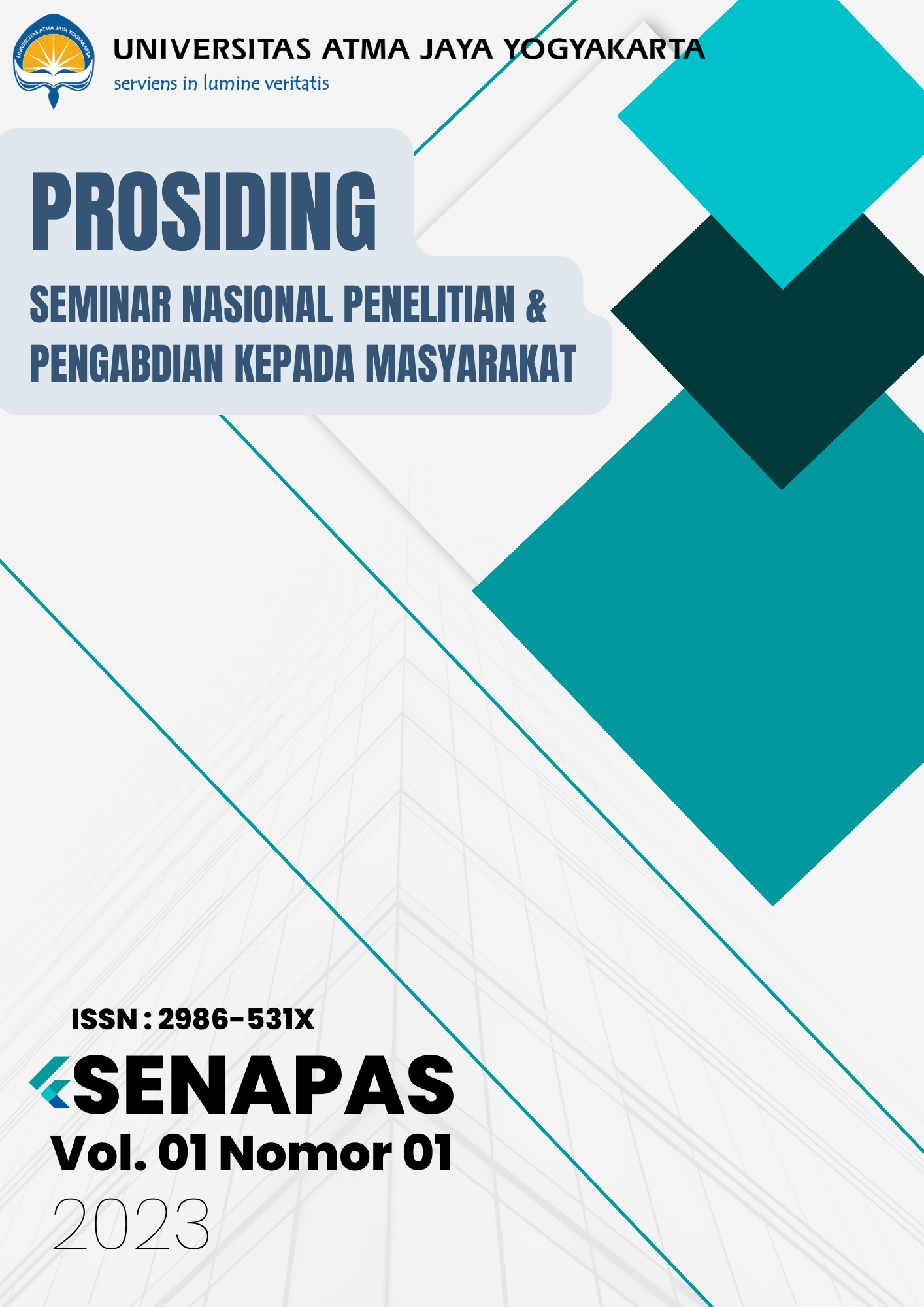Penerapan Kontrol Ruang Pemanas Kayu Hemat Energi dan Biaya di Industri Kerajinan Kayu CV AAG
DOI:
https://doi.org/10.24002/senapas.v1i1.7286Keywords:
produk kerajinan kayu, kadar air kayu, ruang pemanas kayu, hemat energi, hemat biayaAbstract
Produk kerajinan kayu rentan terhadap jamur. Jamur akan tumbuh dengan cepat ketika kelembaban atau kadar air kayu melebihi 20% [1]. Pemanasan kayu dapat mengeringkan dan mengurangi kadar air pada kayu. Pengeringan dengan panas sinar matahari memakan waktu lama. Untuk mendapatkan proses pengeringan yang cepat diperlukan ruang pemanas kayu yang dapat diatur suhu dan kelembaban ruangannya. Dalam kegiatan pengabdian penerapan teknologi di CV AAG, telah dihasilkan ruang pemanas kayu dengan ukuran 3 x 6 x 2,5 meter kubik, yang suhu dan kelembaban ruangannya dapat dimonitor dan dikontrol secara efektif melalui tampilan layar sentuh. Penghematan energi dihasilkan karena kontrol ruang pemanas kayu dirakit dengan alat-alat yang konsumsi daya listriknya rendah, dan dapat bekerja secara otomatis menghasilkan target kelembaban 10 – 15% dengan durasi waktu pemanasan mengikuti jenis dan volume kayu. Penghematan biaya diperoleh karena menggunakan tungku berbahan bakar limbah serbuk kayu yang banyak dihasilkan saat proses pengerjaan kayu.
References
D. Tudor, S.C. Robinson, and P.A. Cooper, "The influence of moisture content variation on fungal pigment formation in spalted wood," 2012. [Online]. Available: http://www.amb-express.com/content/2/1/69.
S. Avramidis, C. Lazarescu, and S. Rahimi, “Basics of Wood Drying,” in Springer Handbooks, Springer Science and Business Media Deutschland GmbH, 2023, pp. 679–706.
L. B. López-Sosa et al., “A new methodology for the development of appropriate technology: A case study for the development of a wood solar dryer,” Sustain., vol. 11, no. 20, Oct. 2019, doi: 10.3390/su11205620.
M. Adedipe and S. Ayeni, “Design, Fabrication and Performance Test of an Active Solar Kiln Dryer for Drying Pulp Lap,” 2018. [Online]. Available: www.sgpicanada.com
O. Adiyanto, M. Faishal, and U. Ahmad Dahlan Yogyakarta, “Transfer Teknologi Melalui Program Kemitraan Masyarakat untuk UKM Kayu Tunas Karya Gumawang,” J. Pengabdi. Kpd. Masy., vol. 11, no. 4, pp. 455–459, [Online]. Available: http://journal.upgris.ac.id/index.php/e-dimas.
P. Kanisius Purwadi, Y. B. Lukiyanto, and S. Mungkasi, “Peningkatan Pemahaman Proses Pengeringan Kayu Di Smk Pangudi Luhur Muntilan,” Abdimas Dewantara, vol. 3, no. 2, pp. 16–29, 2020.
W. Kusbandono and P. Kanisius Purwadi, “Effects of the Existence of Fan in the Wood Drying Room and the Performance of the Electric Energy Wood Dryer,” Int. J. Appl. Sci. Smart Technol., vol. 3, no. 1, pp. 83–92.
P. K. Purwadi and A. Prasetyadi, “Characteristics of Wooden Furniture Drying Machine,” Int. J. Appl. Sci. Smart Technol., vol. 4, no. 1, pp. 75–88, Jun. 2022, doi: 10.24071/ijasst.v4i1.4755.
S. Rahimi, V. Nasir, S. Avramidis, and F. Sassani, “The Role of Drying Schedule and Conditioning in Moisture Uniformity in Wood: A Machine Learning Approach,” Polymers (Basel)., vol. 15, no. 4, Feb. 2023, doi: 10.3390/polym15040792.
X. George Wang, W. Lid, L. Gu, C. Jim Sun, C. Elton Gu, and Clarence W. de Silvaq, “Development Of An Intelligent Control System For Wood Drying Processes,” 2001.
R. A. Ananias, M. Mena, D. M. Elustondo, J. E. Diaz-Vaz, L. Valenzuela, and C. Salinas, “Testing New In-Kiln Meter for Monitoring Lumber Moisture Content during Drying,” Dry. Technol., vol. 31, no. 3, pp. 277–281, Feb. 2013, doi: 10.1080/07373937.2012.725234.
Z. Situmorang, R. Wardoyo, S. Hartati, and J. E. Istiyanto, “Fuzzy rule Suram for control system of a solar energy wood drying chamber,” in AIP Conference Proceedings, 2009, vol. 1159, pp. 103–110, doi: 10.1063/1.3223912.
K. Svoboda, J. Martinec, M. Pohořelý, and D. Baxter, “Integration of biomass drying with combustion/gasification technologies and minimization of emissions of organic compounds,” Chemical Papers, vol. 63, no. 1. pp. 15–25, Feb. 2009, doi: 10.2478/s11696-008-0080-5.
M. Dulǎu and I. Madaras, “Development of a Monitoring and Control System for Timber’s Drying Process,” in Procedia Manufacturing, 2019, vol. 32, pp. 545–552, doi: 10.1016/j.promfg.2019.02.251.
A. J. V. Zanuncio, A. G. Carvalho, C. A. Araújo Júnior, M. R. de Assis, and L. F. da Silva, “Neuro-fuzzy hybrid system for monitoring wood moisture content during drying,” Floresta e Ambient., vol. 26, no. 2, 2019, doi: 10.1590/2179-8087.050417.
Downloads
Published
Issue
Section
License
Copyright (c) 2023 dian artanto, Ignatius Deradjad Pranowo, Martinus Bagus Wicaksono

This work is licensed under a Creative Commons Attribution-ShareAlike 4.0 International License.









